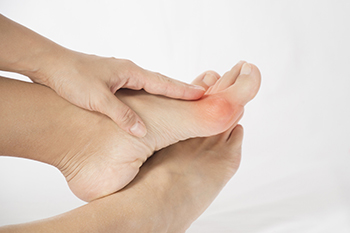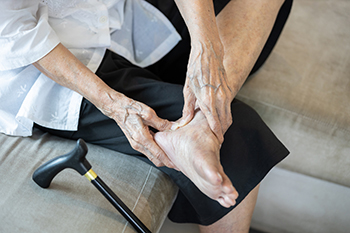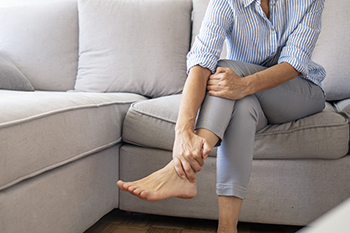Port Neches, TX (409) 727-1122
October 2022
A Bunion May Require Larger Shoes

A bunion is a bony lump that forms on the side of the big toe. Bunions can be caused by several things like genetics or from wearing shoes that do not have adequate room for the toes to move freely in. This condition may also develop from a toe injury that caused the bones to misalign. Eventually, a callus may form over the bunion as a result of the bunion constantly rubbing against the inside of the shoes that are worn. Some patients find it beneficial to wear a protective covering over the bunion and many will also purchase larger shoes to accommodate it. Massaging the affected area may aid in keeping the toe flexible and the surrounding tissue soft. An effective massage can be rolling the foot on a tennis ball and performing foot exercises may help to strengthen the muscles in the toes too. It is easier to find shoes that fit properly if they are tried on at the end of the day when the feet are at their largest. If you see the first signs of a small bump developing on the side of the big toe, please consult with a podiatrist who can determine if it is a bunion and what the right treatment is for you.
If you are suffering from bunion pain, contact Pete O’Donald, DPM of Texas. Our doctor can provide the care you need to keep you pain-free and on your feet.
What Is a Bunion?
Bunions are painful bony bumps that usually develop on the inside of the foot at the joint of the big toe. As the deformity increases over time, it may become painful to walk and wear shoes. Women are more likely to exacerbate existing bunions since they often wear tight, narrow shoes that shift their toes together. Bunion pain can be relieved by wearing wider shoes with enough room for the toes.
Causes
- Genetics – some people inherit feet that are more prone to bunion development
- Inflammatory Conditions - rheumatoid arthritis and polio may cause bunion development
Symptoms
- Redness and inflammation
- Pain and tenderness
- Callus or corns on the bump
- Restricted motion in the big toe
In order to diagnose your bunion, your podiatrist may ask about your medical history, symptoms, and general health. Your doctor might also order an x-ray to take a closer look at your feet. Nonsurgical treatment options include orthotics, padding, icing, changes in footwear, and medication. If nonsurgical treatments don’t alleviate your bunion pain, surgery may be necessary.
If you have any questions, please feel free to contact our office located in Nederland, TX . We offer the newest diagnostic and treatment technologies for all your foot care needs.
Foot Problems Common to Seniors

Foot pain in seniors often interferes with daily activities, such as walking, climbing stairs, and even getting out of a chair. It may also affect the balance, which increases the likelihood of falling. Further, movement difficulty contributes to muscle weakness, weight gain, and diminished heart function. One of the most common causes of foot pain in seniors is wearing shoes that do not fit properly. It is believed that three-fourths of seniors over 65 wear shoes that are too small for their feet. In addition, narrow shoes and high-heels, along with footwear that lacks the proper support, contribute to pain, injuries, and risk of falling. Other common types of foot pain in older adults include bunions, calluses and corns, hammertoe, toenail problems, and heel problems. Additional causes are diabetes-related foot problems, such as ulcers and wounds that will not heal, and arthritis-related toe problems, such as gout. If you are experiencing foot pain that inhibits your life, please consult with a podiatrist for an examination and suggested treatment options.
Proper foot care is something many older adults forget to consider. If you have any concerns about your feet and ankles, contact Pete O’Donald, DPM from Texas. Our doctor can provide the care you need to keep you pain-free and on your feet.
The Elderly and Their Feet
As we age we start to notice many changes in our body, but the elder population may not notice them right away. Medical conditions may prevent the elderly to take notice of their foot health right away. Poor vision is a lead contributor to not taking action for the elderly.
Common Conditions
- Neuropathy – can reduce feeling in the feet and can hide many life-threatening medical conditions.
- Reduced flexibility – prevents the ability of proper toenail trimming, and foot cleaning. If left untreated, it may lead to further medical issues.
- Foot sores – amongst the older population can be serious before they are discovered. Some of the problematic conditions they may face are:
- Gouging toenails affecting nearby toe
- Shoes that don’t fit properly
- Pressure sores
- Loss of circulation in legs & feet
- Edema & swelling of feet and ankles
Susceptible Infections
Diabetes and poor circulation can cause general loss of sensitivity over the years, turning a simple cut into a serious issue.
If you have any questions please feel free to contact our office located in Nederland, TX . We offer the newest diagnostic and treatment technologies for all your foot and ankle needs.
Rheumatoid Arthritis and the Toes

Individuals living with rheumatoid arthritis (RA) may experience swelling in certain smaller joints in the body, including those in the toes of the feet. RA can cause a number of different toe conditions to be aware of. Notably, it can cause claw toe, which is a condition where the toes essentially twist or bend into a position that resembles a claw. People with rheumatoid arthritis may also have bursitis, which is when the fluid sacs in the joints become aggravated and inflamed. Another common toe condition for those with RA is corns of the feet, thick areas of skin that develop in response to friction. These are just some of the different relevant toe conditions for those with RA. It is important to note that people with this kind of arthritis can experience a combination of different toe conditions at the same time, which can make wearing shoes especially uncomfortable. Contact a podiatrist today if you are living with rheumatoid arthritis and want to protect your toes.
Because RA affects more than just your joints, including the joints in your feet and ankles, it is important to seek early diagnosis from your podiatrist if you feel like the pain in your feet might be caused by RA. For more information, contact Pete O’Donald, DPM of Texas. Our doctor will assist you with all of your podiatric concerns.
What Is Rheumatoid Arthritis?
Rheumatoid Arthritis (RA) is an autoimmune disorder in which the body’s own immune system attacks the membranes surrounding the joints. Inflammation of the lining and eventually the destruction of the joint’s cartilage and bone occur, causing severe pain and immobility.
Rheumatoid Arthritis of the Feet
Although RA usually attacks multiple bones and joints throughout the entire body, almost 90 percent of cases result in pain in the foot or ankle area.
Symptoms
- Swelling and pain in the feet
- Stiffness in the feet
- Pain on the ball or sole of feet
- Joint shift and deformation
Diagnosis
Quick diagnosis of RA in the feet is important so that the podiatrist can treat the area effectively. Your doctor will ask you about your medical history, occupation, and lifestyle to determine the origin of the condition. Rheumatoid Factor tests help to determine if someone is affected by the disease.
If you have any questions please feel free to contact our office located in Nederland, TX . We offer the newest diagnostic and treatment technologies for all your foot and ankle needs.
Do Your Child's Feet Hurt?
Rare Diabetes Foot Complications

Charcot foot used to be a rare diabetes complication. It was said to affect less than 1% of people with diabetes. Now experts say it is becoming more common, and there is worry that patients and their care providers do not know about this diabetic complication or its warning signs. Charcot foot is a sudden softening of the foot’s bones, caused by neuropathy or nerve damage from diabetes. It can lead to a host of serious problems, such as joint loss, fractures, and amputation. As the condition worsens, the bottom of the foot can become convex and bulge out. Since many diabetics do not feel pain in their lower extremities, they continue walking on the foot, which can cause further problems. This disorder cannot be reversed, but its dangerous effects can be halted if dealt with early. Symptoms appear suddenly and include warm, red skin, swelling, and pain. Unfortunately, these symptoms can also be a sign of deep vein thrombosis or an infection. If you are diabetic, it is important to include a podiatrist as part of your medical care team. They are educated in foot disorders that other doctors may not be aware of or are trained to treat.
Diabetic foot care is important in preventing foot ailments such as ulcers. If you are suffering from diabetes or have any other concerns about your feet, contact Pete O’Donald, DPM from Texas. Our doctor can provide the care you need to keep you pain-free and on your feet.
Diabetic Foot Care
Diabetes affects millions of people every year. The condition can damage blood vessels in many parts of the body, especially the feet. Because of this, taking care of your feet is essential if you have diabetes, and having a podiatrist help monitor your foot health is highly recommended.
The Importance of Caring for Your Feet
- Routinely inspect your feet for bruises or sores.
- Wear socks that fit your feet comfortably.
- Wear comfortable shoes that provide adequate support.
Patients with diabetes should have their doctor monitor their blood levels, as blood sugar levels play such a huge role in diabetic care. Monitoring these levels on a regular basis is highly advised.
It is always best to inform your healthcare professional of any concerns you may have regarding your feet, especially for diabetic patients. Early treatment and routine foot examinations are keys to maintaining proper health, especially because severe complications can arise if proper treatment is not applied.
If you have any questions please feel free to contact our office located in Nederland, TX . We offer the newest diagnostic and treatment technologies for all your foot and ankle needs.





